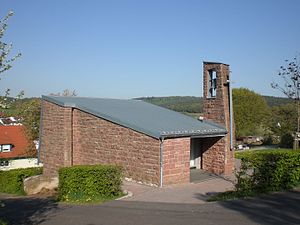Giesel cemetery chapel
| Giesel cemetery chapel | |
|---|---|
 |
|
| Data | |
| place | Giesel |
| architect | Architects Weber, Fulda and Herbert Roer, Margetshöchheim |
| Builder | Giesel community |
| Architectural style | Modern sandstone construction |
| Construction year | 1962 |
| Coordinates | Degree errors: NS : no number EW : no number |
The Giesel cemetery chapel at the Giesel cemetery , a district of the Neuhof municipality in the eastern Hessian district of Fulda, is a smaller cemetery chapel for worship services, funeral ceremonies, devotions and funeral services.
history
In 1958/1960, as part of the land consolidation in Giesel under Mayor Leonhard Glozbach, an area to extend the new cemetery above Sudetenstrasse, a new building area for a mourning hall and new grave sites, was created. The cemetery was expanded to the south.
The chapel was designed by the architects Weber, Fulda and Herbert Roer, Margetshöchheim , who were also the planners of the new parish church St. Laurentius from 1962.
The cemetery chapel stands at the southern end of the cemetery extension opposite the new cemetery cross made of red sandstone, which was also erected at the same time . It was created by the sculptor Siegfried Fleck from Fulda.
In 1961 the new cemetery chapel was built on the extension area. The inauguration of the chapel and the cemetery cross took place in 1963 by the pastor of Giesel Josef Mönninger .
renovation
In the course of the first fundamental renovation in 2009, the old wooden ceiling paneling from 1961 in the interior of the chapel was replaced with a plasterboard perforated ceiling , the lighting was modernized and the old Eternit slate roof was newly covered with a zinc sheet roofing.
The ecclesiastical blessing and reopening took place on March 21, 2009. The ecumenical blessing was performed by the Protestant pastor Karl-Heinrich Ostmeyer (Bronnzell) and the Catholic pastor Winfried Abel (Giesel). Musically, the blessing and handover were designed by the music association "Heimatklänge" under the conductor Amand Leinweber.
Coordinates: 50 ° 30 ′ 5.5 ″ N , 9 ° 34 ′ 26.8 ″ E
